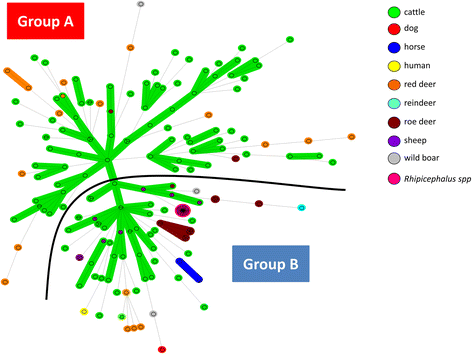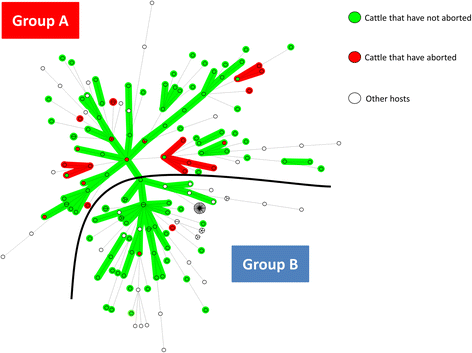Multiple-locus variable-number tandem repeat analysis potentially reveals the existence of two groups of Anaplasma phagocytophilum circulating in cattle in France with different wild reservoirs
- PMID: 27876073
- PMCID: PMC5120488
- DOI: 10.1186/s13071-016-1888-4
Multiple-locus variable-number tandem repeat analysis potentially reveals the existence of two groups of Anaplasma phagocytophilum circulating in cattle in France with different wild reservoirs
Abstract
Background: Anaplasma phagocytophilum is the causative agent of tick-borne fever, a disease with high economic impact for domestic ruminants in Europe. Epidemiological cycles of this species are complex, and involve different ecotypes circulating in various host species. To date, these epidemiological cycles are poorly understood, especially in Europe, as European reservoir hosts (i.e. vertebrate hosts enabling long-term maintenance of the bacterium in the ecosystem), of the bacterium have not yet been clearly identified. In this study, our objective was to explore the presence, the prevalence, and the genetic diversity of A. phagocytophilum in wild animals, in order to better understand their implications as reservoir hosts of this pathogen.
Methods: The spleens of 101 wild animals were collected from central France and tested for the presence of A. phagocytophilum DNA by msp2 qPCR. Positive samples were then typed by multi-locus variable-number tandem repeat (VNTR) analysis (MLVA), and compared to 179 previously typed A. phagocytophilum samples.
Results: Anaplasma phagocytophilum DNA was detected in 82/101 (81.2%) animals including 48/49 red deer (98%), 20/21 roe deer (95.2%), 13/29 wild boars (44.8%), and 1/1 red fox. MLVA enabled the discrimination of two A. phagocytophilum groups: group A contained the majority of A. phagocytophilum from red deer and two thirds of those from cattle, while group B included a human strain and variants from diverse animal species, i.e. sheep, dogs, a horse, the majority of variants from roe deer, and the remaining variants from cattle and red deer.
Conclusions: Our results suggest that red deer and roe deer are promising A. phagocytophilum reservoir host candidates. Moreover, we also showed that A. phagocytophilum potentially circulates in at least two epidemiological cycles in French cattle. The first cycle may involve red deer as reservoir hosts and cattle as accidental hosts for Group A strains, whereas the second cycle could involve roe deer as reservoir hosts and at least domestic ruminants, dogs, horses, and humans as accidental hosts for Group B strains.
Keywords: Anaplasma phagocytophilum; France; Group A; Group B; MLVA; Red deer; Reservoir; Roe deer; VNTR; Wild boars.
Figures


Similar articles
-
Co-circulation of different A. phagocytophilum variants within cattle herds and possible reservoir role for cattle.Parasit Vectors. 2018 Mar 9;11(1):163. doi: 10.1186/s13071-018-2661-7. Parasit Vectors. 2018. PMID: 29523202 Free PMC article.
-
A new multiple-locus variable-number tandem repeat analysis reveals different clusters for Anaplasma phagocytophilum circulating in domestic and wild ruminants.Parasit Vectors. 2014 Sep 16;7:439. doi: 10.1186/1756-3305-7-439. Parasit Vectors. 2014. PMID: 25228371 Free PMC article.
-
Multilocus sequence analysis of Anaplasma phagocytophilum reveals three distinct lineages with different host ranges in clinically ill French cattle.Vet Res. 2014 Dec 9;45:114. doi: 10.1186/s13567-014-0114-7. Vet Res. 2014. PMID: 25487348 Free PMC article.
-
Anaplasma marginale and Anaplasma phagocytophilum: Rickettsiales pathogens of veterinary and public health significance.Parasitol Res. 2015 Nov;114(11):3941-57. doi: 10.1007/s00436-015-4698-2. Epub 2015 Sep 7. Parasitol Res. 2015. PMID: 26346451 Review.
-
[Ixodes ricinus, transmitted diseases and reservoirs].Parassitologia. 2004 Jun;46(1-2):119-22. Parassitologia. 2004. PMID: 15305699 Review. Italian.
Cited by
-
Tick-borne pathogens in Ixodidae ticks collected from privately-owned dogs in Italy: a country-wide molecular survey.BMC Vet Res. 2020 Feb 7;16(1):46. doi: 10.1186/s12917-020-2263-4. BMC Vet Res. 2020. PMID: 32028946 Free PMC article.
-
The Occurrence of Zoonotic Anaplasma phagocytophilum Strains, in the Spleen and Liver of Wild Boars from North-West and Central Parts of Poland.Acta Parasitol. 2021 Sep;66(3):1082-1085. doi: 10.1007/s11686-021-00368-6. Epub 2021 Mar 26. Acta Parasitol. 2021. PMID: 33770340 Free PMC article.
-
Detecting and characterizing mixed infections with genetic variants of Anaplasma phagocytophilum in roe deer (Capreolus capreolus) by developing an ankA cluster-specific nested PCR.Parasit Vectors. 2017 Aug 7;10(1):377. doi: 10.1186/s13071-017-2316-0. Parasit Vectors. 2017. PMID: 28784148 Free PMC article.
-
Co-circulation of different A. phagocytophilum variants within cattle herds and possible reservoir role for cattle.Parasit Vectors. 2018 Mar 9;11(1):163. doi: 10.1186/s13071-018-2661-7. Parasit Vectors. 2018. PMID: 29523202 Free PMC article.
-
The Impact of Altitude on Tick-Borne Pathogens at Two Mountain Ranges in Central Slovakia.Pathogens. 2024 Jul 15;13(7):586. doi: 10.3390/pathogens13070586. Pathogens. 2024. PMID: 39057813 Free PMC article.
References
-
- Adams D, Jajosky R, Ajani U, Kriseman J, Sharp P, Onweh D, et al. Morbidity mortality weekly report summary of notifiable diseases. Centers for Disease Control and Prevention. 2014. Annual Cases of Anaplasmosis in the United States.
Publication types
MeSH terms
LinkOut - more resources
Full Text Sources
Other Literature Sources

